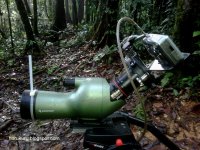pimpelmees
Well-known member
I can buy a used nikon ed82 scope with 30x oculair, but i am looking also to a leica 65 mm apo with the 25x50 oculair (new), what is the best choice ???,
- I am afraid that the nikon will be to heavy to take always around and that
when i want a bird closer sometimes , i have to buy a 50mm ? oculair also !!
- With the leica i will have both worlds , the smaller size and weight and a
very good zoom with always the same field of view from 25 to 50x !! (is
this true) ??
- about the leica 65; have i enough light when its darker outside , is this a
problem ??? and what about field of view against a 82mm ?
- I want to use the scope without a case , even when its rains ??
- What about finding birds in flight; with leica and swaro i have a few times tried but that wasn't that easy , is this becoming more easy with use ??
- swarovski 65 has fallen of because the new zoom give me blackouts and
bad eyeplacement !!
- I am afraid that the nikon will be to heavy to take always around and that
when i want a bird closer sometimes , i have to buy a 50mm ? oculair also !!
- With the leica i will have both worlds , the smaller size and weight and a
very good zoom with always the same field of view from 25 to 50x !! (is
this true) ??
- about the leica 65; have i enough light when its darker outside , is this a
problem ??? and what about field of view against a 82mm ?
- I want to use the scope without a case , even when its rains ??
- What about finding birds in flight; with leica and swaro i have a few times tried but that wasn't that easy , is this becoming more easy with use ??
- swarovski 65 has fallen of because the new zoom give me blackouts and
bad eyeplacement !!







